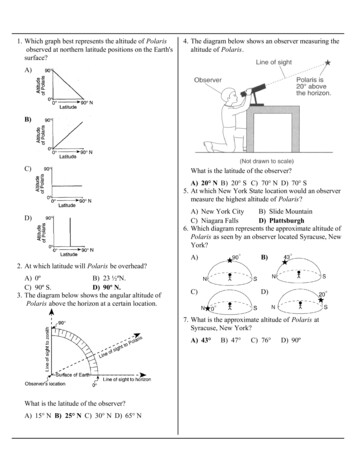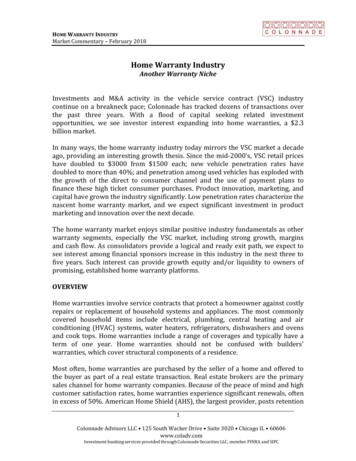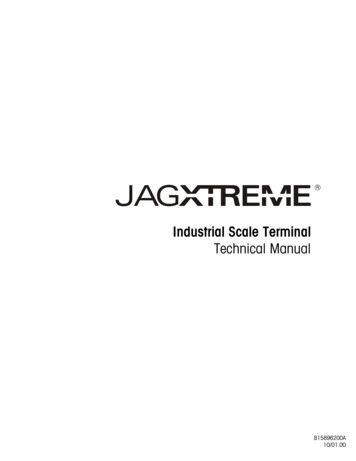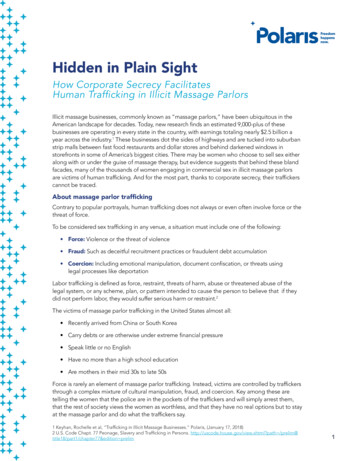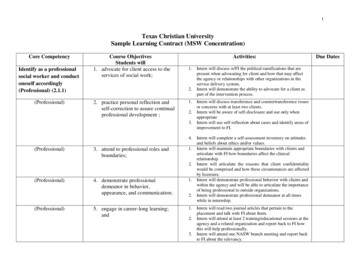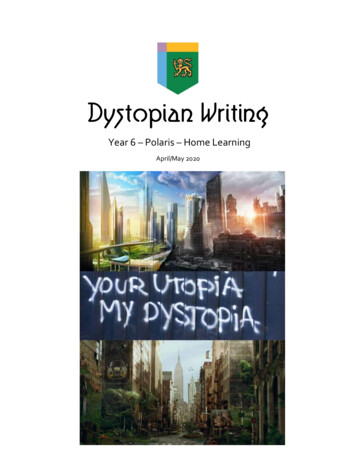
Transcription
Year 6 – Polaris – Home LearningApril/May 2020
Week 1Completed?20.4.2021.4.2022.4.20First News Crossword and Comprehensionpp. 1 – 4Defining Utopia/Dystopiapp. 5 – 6Looking into Dystopian fiction in more detailpp. 7 – 9Week 227.4.2028.4.2029.4.20Guided Reading: Why do we like dystopian novels?pp. 10 – 11George Orwell, 1984 – Chapter One questionspp. 12 – 13Specificity and Granularityp. 14Week 34.5.205.5.206.5.20First News Crossword and Comprehensionp. 15Creating Tensionp. 15Ernest Cline, Ready Player One questionsp. 16Week 411.5.2012.5.2013.5.20Setting – compare features of two novelspp. 17 – 20Create your own settingp. 21Defiance in dystopian writingp. 22Week 518.5.2019.5.2020.5.20First News Crossword and Comprehensionp.23Openings: James Dashner, Maze Runnerp. 23Creating our own openingp. 24
Monday 20th April 2020First News CrosswordFirst News Comprehension1
2
3
4
Tuesday 21st April 2020Utopia and Dystopia‘Nearly all creators of Utopia have resembled the man who has toothache,and therefore thinks happiness consists in not having toothache whoever triesto imagine perfection simply reveals his own emptiness.’George Orwell – ‘Can Socialists be Happy?‘ 1943.The definition of ‘utopia’:The origin of ‘utopia’The British Library: UtopiaFor thousands of years human beings have dreamt of perfect worlds, worlds free of conflict,hunger and unhappiness. But can these worlds ever exist in reality?In 1516 Sir Thomas More wrote the first 'Utopia'. He coined the word 'utopia' from theGreek ou-topos meaning 'no place' or 'nowhere'. But this was a pun - the almost identical Greekword eu-topos means a good place. So at the very heart of the word is a vital question: can aperfect world ever be realised?Questions1.) Explain the pun at the heart of the word ‘utopia’ – what makes the word a joke?2.) List 10 things that would exist in your utopian word – think about how people wouldbe treated, how society would work.3.) Go back to the quote at the top of the page – what does George Orwell think is theflaw with utopias?4.) Draw your own utopian world – use no more than half a page to do this.5
Defining dystopiaThe definition of the word ‘dystopia’The origin of the word ‘dystopia’The British Library: DystopiaThe word most commonly used to describe the opposite of utopia is ‘dystopia’, though when it wascoined by John Stuart Mill in a speech in the House of Commons in 1868 it was not quite in the sensewe use it now. Mill was reflecting on the impossibility of establishing a utopia because the basis of itseconomy and social development was subject to natural laws that cannot be influenced by humanwill, meaning that all utopias have a built-in inevitability of failure. He thus dismissed all utopianthinkers as dystopian, because their ideas were too flawed to be practical.It is ironical, therefore, that the word dystopia has come to represent a society in which individualsare repressed, personal freedoms lost and creativity stifled. A dystopia presents the inhumanity of thesoulless state machine against the hopes and aspirations of humanity.Questions:1.)2.)3.)4.)In your books, define the words ‘totalitarian’ and ‘post-apocalyptic’Where did John Stuart Mill first use the word ‘dystopia’ and when?Why did Mill think that all utopian thinkers were actually dystopian?What does dystopia present according to the extract from the British Library? Pleaseanswer in a full sentence and quote from the source.5.) List 10 things that would be present in your version of a dystopia – think about howpeople would be treated.6
Wednesday 22nd April 2020Pick TWO of the statements from the table and explain why you agree or disagree with them.STATEMENT 1:STATEMENT 2:7
Dystopias: Definition and CharacteristicsUtopia: A place, state, or condition that is ideally perfect in respect of politics, laws, customs, andconditions.Dystopia: A futuristic, imagined universe in which oppressive societal control and the illusion of aperfect society are maintained through corporate, bureaucratic, technological, moral, or totalitariancontrol. Dystopias, through an exaggerated worst-case scenario, make a criticism about a currenttrend, societal norm, or political system.Dystopian Elements and Characteristics - Basic Building Blocks of DystopiaThe dystopian stories are often stories about survival; their primary theme is oppression andrebellion. The environment plays important role in dystopian depiction. Dystopian storiestake place in the large cities devastated by pollution. In every dystopian story, there is backstory of war, revolutions, overpopulation and other disasters.The dystopian depiction is imaginary. Dystopian fiction borrows features from reality anddiscusses them, but it doesn't depict contemporary society in general. Dystopian stories takeplace in the future, but they are about today and sometimes about yesterday.All dystopias are keen on a strict division of the citizens by intellect, ability, and class. In BraveNew World, people are divided in Alphas, Betas, Gammas, Deltas, and Epsilons. In NineteenEighty-Four (1984), there are capitalist and proles, Party and non-Party. In a typical dystopia,there is no social group except the State or such social groups are under government control.Independent religions do not exist among social groups, instead of that, there is a personalitycult (usually of a head of state) created by the State, such as Big Brother in Nineteen EightyFour (1984) and The Benefactor of We.The institution of family has been eradicated in some dystopian societies, as in Brave NewWorld, where children are reproduced artificially. If the family exists in dystopian stories, it isusually in the service of the State as in Nineteen Eighty-Four (1984), where children arethought to spy on their parents.Dystopian tales emphasise a sense of the powerlessness of the individuals in the face of theoppressive and brutal government run by a totalitarian dictatorship, or organized intomassive bureaucratic institutions (as in Nineteen Eighty-Four (1984), the Ministry ofInformation). Paranoia is very evident among the citizens of dystopian societies who live infear and who are being monitored, betrayed or manipulated. The Thought Police and theThought crime in Orwell's Nineteen Eighty-Four (1984) are the most extreme examples ofparanoia. Dystopian fiction features technology more advanced than we have today, and thegroup in power controls it.The standard of living among the classes is lower than in contemporary societies. In NineteenEighty-Four (1984), the upper class of society, The Inner Party has a standard of living poorerthan the upper class in the real word. But in Brave New World and Equilibrium, people havea higher standard of living in exchange for a loss of independent thought and emotions.8
The hero in dystopian literature always questions society although he is usually in highstanding within the social system. He often sees what's wrong and tries to change thesystem. He puts his hope in a group of people who aren't under the complete control of thestate, in Nineteen Eighty-Four (1984), they are "proles", in Brave New World they are peopleon the reservation and in We, they are people outside the walls of the One State. His goal iseither to escape or destruction of the society's principals, but usually, he fails in his intentionto change anything, and sometimes they themselves end up changed to conform to thesociety's rules.Dystopia is subgenre of science fiction, because it depicts future fictive societies, and manyof them use other elements of science fiction like time travel, space flight, amazing andadvanced technologies, etc.There is also a particular relationship between dystopian fiction and film noir, such asstartling contrasts, symbolic shadow and the action that takes place during the night.SOURCE: n-elements-and-characteristic/ DYSTOPIAN FICTION According to the source, what are the features of dystopian fiction? Create a bullet pointlist with as many details as possible. If you were to create your own dystopian novel, how would you reflect the features of adystopian story? Using the features identified to guide you, create an outline for yourstory.Choose one novel and create a dystopian fact-file outlining how and why it is a goodexemplar of this genre.Include:o Plot summaryo Main characterso Connections to the expected features of dystopian fictiono Reviews from readers and commentaries from expertso Personal reflection Research Zone The American Library Association (ALA) often gets requests for dystopian novels to be bannedfor being subversive or dangerous (especially for impressionable young adults). In the past,books such as ‘Brave New World’, ‘Fahrenheit 451’ and ‘The Giver’ have all been banned fromAmerican libraries.Do some research into book banning and write a speech or letter in response to this stand.You might like to consider the answers to these questions: Do you agree with the ALA’s right to decide which books are deserving? Are there some books which should be banned from public and school libraries? Who should get to decide which books to include in libraries and studied in schools?9
Monday 27th April 2020Why Do We Like Dystopian Novels?Dave Astor, ContributorAuthor, ‘Comic (and Column) Confessional’10/19/2012 01:44 pm ET Updated Dec 19, 2012War. Death. Despair. Oppression. Environmental ruin. Yup, when it comes to demoralizingliterature, dystopian novels have it all! Yet many of us love this genre, and there are goodreasons we do.For one thing, we’re reading about rather than actually living through the bad stuffhappening in the near or far future (though that bad stuff is often an extrapolation of ourtroubled current world). We’re not “in the arena” like the beleaguered tributes of The HungerGames, the dystopian trilogy I recently finished.And, while dystopian novels are depressing, there’s a certain “rightness” in reading about afuture that’s negative. Why? Because we know that politicians, military people and corporatemoguls are capable of doing awful things — meaning dystopian novels feel kind of honest.The Hunger Games certainly felt honest. That terrific trilogy gives its memorable characterssome uplifting moments, but there are a greater number of downbeat outcomes — especiallyin the third instalment, Mockingjay. So, even though The Hunger Games (first book) andCatching Fire (second book) are more engaging (albeit often horrific), the final book trulyrings true. Dictatorship, revolution and counterrevolution usually cause severe physical andpsychological damage to the victims and other participants. To her credit, author SuzanneCollins doesn’t sanitize that for us.Other excellent dystopian novels are also filled with carnage, inhumanity, hopelessness andmore. Aldous Huxley’s Brave New World. George Orwell’s 1984 and Animal Farm. H.G. Wells’The Time Machine and The Shape of Things to Come. Mary Shelley’s The Last Man. LoisLowry’s The Giver. Cormac McCarthy’s The Road. Ray Bradbury’s Fahrenheit 451. AnthonyBurgess’ A Clockwork Orange. William Golding’s Lord of the Flies. Sinclair Lewis’ It Can’tHappen Here. Jack London’s The Iron Heel. Margaret Atwood’s The Handmaid’s Tale, Oryx andCrake, and The Year of the Flood. Etc.Sometimes, authors of dystopian literature temporarily ease the tension a bit with humour,as the great Atwood does with some of the clever genetic-engineering terms she coined forOryx and Crake. And dystopian books can have seemingly utopian elements — with thingsnot appearing too bad even though they are bad; Brave New World is a perfect example.There are even novels, such as The Shape of Things to Come, that mix dystopian and actualutopian elements.We admire the best dystopian novels because they’re written well and depict people we canrelate to. We’re fascinated by the terrible things these characters face, and by how somereact bravely and some react cowardly or with resignation. We, as readers, rubberneck to see10
the misery; we can’t avert our eyes even as we’re enraged by what despots and other viciousofficials are doing to citizens. And we’re compelled to turn the pages as we wonder if rebelsand other members of the populace can somehow remake a wretched society intosomething more positive. We also wonder who will survive and who won’t; I was surprised bysome of the characters who end up dying in The Hunger Games (a trilogy I read on theenthusiastic recommendation of commenter “threnodymarch”).Last but not least, we admire dystopian novels because, by giving us worst-case scenarios ofthe future, maybe our current society can be jolted enough to avoid those scenarioseventually happening in real life. Like some of the characters in dystopian novels, we mightfeel a little against-all-odds hope. Then again, maybe not.What are your favourite dystopian novels, and why do you like them? Or are you not thatfond of the genre, and why? Answer these questions in your book 1. According to the source, what kinds of disasters often feature in dystopian fiction?2. What are the reasons Astor gives for why we love dystopian novels?3. Aston says that ‘dystopian novels feel kind of honest’, what do you think he means bythat? Do you think he is right?4. Often dystopian novels are written for younger audiences and marketed as YA (youngadult) literature. Because of this, some argue that it should not be considered as worthyof literary study and consideration alongside the traditional classic texts. Do you thinkdystopian literature has an important place in accepted literary canon1?111The term “literary canon” refers to a body of books, narratives and other texts considered to be themost important and influential of a particular time period or place.
Tuesday 28th April 20201984; George Orwell: Chapter OneIt was a bright cold day in April, and the clocks were striking thirteen. Winston Smith, his chinnuzzled into his chest in an effort to escape the vile wind, slipped quickly through the glassdoors of Victory Mansions, though not quickly enough to prevent a swirl of gritty dust fromentering along with him.The hallway smelt of boiled cabbage and old rag mats. At one end of it a coloured poster, toolarge for indoor display, had been tacked to the wall. It depicted simply an enormous face,more than a metre wide: the face of a man of about forty-five, with a heavy black moustacheand ruggedly handsome features. Winston made for the stairs. It was no use trying the lift.Even at the best of times it was seldom working, and at present the electric current was cutoff during daylight hours. This was part of the economy drive in preparation for Hate Week.The flat was seven flights up and Winston, who was thirty-nine and had a varicose ulcer abovehis right ankle, went slowly, resting several times on the way. On each landing, opposite thelift shaft, the poster with the enormous face gazed from the wall. It was one of those pictureswhich are so contrived that the eyes follow you about when you move. BIG BROTHER ISWATCHING YOU, the caption beneath it ran.Inside the flat a fruity voice was reading out a list of figures which had something to do withthe production of pig-iron. The voice came from an oblong metal plaque like a dulled mirrorwhich formed part of the surface of the right-hand wall. Winston turned a switch and thevoice sank somewhat, though the words were still distinguishable. The device (a telescreen,it was called) could be dimmed, but there was no way of switching it off completely. Hemoved over to the window: a smallish, frail figure, the thinness of his body merelyemphasised by the blue overalls which were the uniform of the Party. His hair was very fair,his face naturally ruddy, his skin roughened by coarse soap and blunt razor blades and thecold of the winter that had just ended.Outside, even through the shut window-pane, the world looked cold. Down in the street littleeddies of wind were whirling dust and torn paper into spirals, and though the sun was shiningand the sky a harsh blue, there seemed to be no colour in anything, except the posters thatwere plastered everywhere. The black-moustachio’d face gazed down from everycommanding corner. There was one on the house-front immediately opposite. BIGBROTHER IS WATCHING YOU, the caption said, while the dark eyes looked deep intoWinston’s own. Down at street level another poster, torn at one corner, flapped fitfully in thewind, alternately covering and uncovering the single word INGSOC. In the far distance ahelicopter skimmed down between the roofs, hovered for an instant like a bluebottle, anddarted away with a curving flight. It was a police patrol, snooping into people’s windows. Thepatrols did not matter, however. Only the Thought Police mattered.Winston looked out of his window towards a huge building several kilometres away.The Ministry of Truth was startlingly different from any other object in sight. It was anenormous pyramidal structure of glittering white concrete, soaring up, terrace after terrace,three hundred metres into the air. From where Winston stood it was just possible to read,picked out on its white face in elegant lettering, the three slogans of the Party:12
WAR IS PEACEFREEDOM IS SLAVERYIGNORANCE IS STRENGTHThe Ministry of Truth contained, it was said, three thousand rooms above ground level andsimilar numbers below. Scattered about London there were just three other buildings ofsimilar appearance and size. So completely did they dwarf the surrounding buildings thatfrom the roof of Victory Mansions you could see all four of them simultaneously. They werethe homes of the four Ministries between which the entire government was divided. TheMinistry of Truth which concerned itself with news, entertainment, education and the finearts. The Ministry of Peace which concerned itself with war. The Ministry of Love whichmaintained law and order. And the Ministry of Plenty which was responsible for economicaffairs. Their names, in Newspeak: Minitrue, Minipax, Miniluv and Miniplenty.The Ministry of Love was the really frightening one. There were no windows in it at all.Winston had never been inside the Ministry of Love, nor within half a kilometre of it. It wasa place impossible to enter except on official business, and then only by penetrating througha maze of barbed-wire entanglements, steel doors and hidden machine-gun nests. Even thestreets leading up to its outer barriers were roamed by gorilla-faced in black uniforms, armedwith jointed truncheons. Answer these questions in your book 1. What clues are there in the text that this story is taking placein a dystopian world? How does this make the reader feel?Why does it make the reader feel this way?2. When do you think this story is set? Why?3. What do you think day to day life is like for Winston? Why doyou think this? Back your ideas up with a quotation from thetext.4. ‘Frail’. ‘Thin’. ‘Ruddy’. Three adjectives used to describeWinston. Why do you think George Orwell has used theseadjectives? What do they make you think of and whatimpression do you get of Winston’s character because ofthem? Why do you think Winston is ‘frail’ and ‘thin’?5. Find out what the word ‘foreshadowing’ means. Is there anexample of foreshadowing in the extract? If so, what is it?Why is this an example of foreshadowing?6. Who do you think ‘The Party’ are? Explain your ideas.7. What do the words ‘BIG BROTHER IS WATCHING YOU’ suggest to the reader about theworld these characters live in?8. Compare the description of the man on the poster with the description of Winston. Whatdo you notice? Why do you think this is?9. Pick out five conventions of dystopian fiction. You may use examples you have alreadyfound.13
Wednesday 29th April 2020Nouns: Specificity and granularity and tension.Nouns refer to people, places, things, ideas and events; they are often naming words. Thenouns we choose in our writing helps to set the mood of the text. How much is revealed andwhen can create tension, surprises, and helps the reader experience events alongside thecharacters in the story.Have a look at this extract, pay particular attention to how Colfer introduces the dangerButler is facing:Something moved in the dust haze. It was immediately obvious to Butler that the somethingwasn’t human. The manservant had been on too many safaris not to recognise an animalwhen he saw it. He studied the creature’s gait. Possibly simian1. Similar upper-body structureto an ape, but bigger than any primate Butler had ever seen. If it was an ape, then his handgunwasn’t going to be of much use. You could put five rounds in the skull of a bull ape and he’dstill have time to eat you before his brain realised he was dead.But it wasn’t an ape. Apes didn’t have night eyes. This creature did. Glowing crimson pupils,half-hidden behind shaggy forelocks. Tusks too, but not elephantine. These were curved,with serrated edges. Gutting weapons. Butler felt a tingle low in his stomach. He’s had thefeeling once before. On his first day at the Swiss academy. It was fear.Aretmis Fowl, Eoin ColferSpecificity can refer to how precisely something is named. The more ambiguous2 an object,the more unsettling or surprising it may be. Determining how precise your noun will be helpsthe readers decide how to feel about the events or characters.Shadow figure someone youth boy brother James JimmyGranularity To raise tension in moments like the one Butler faces in the extract, details arerarely given all at once, instead the narrator may give glimpses or an outline description, oreven run through options of what it is not. Collect together all of the nouns Colfer uses to describe the danger Read line 7-10, how does Colfer make use of granularity to raise tension? Butler’s character is typically written to appear calm and professional.o How does Colfer reflect this through his noun choices?o Is this sense of calm undermined in any way?o How does Colfer use sentence length and type (especially when coupled withspecificity) to reflect Butler’s state of mind? Writing ChallengeHave a go describing a dinosaur using the techniques of specificity and granularity.o Which elements will you focus on?o Which nouns will you use to create tension and surprise?1simian – a formal/scientific term for apes and monkeys.ambiguous – unclear, giving away little information or details214
Monday 4th May 2020First News yet to be published – see blog for learning/sheetsTuesday 5th May 2020Nouns: TensionThe door starts shaking. It’s a flimsy thing made of bamboo shoots held together with tatteredlengths of twine. The shake is subtle and stops almost immediately. They lift their heads to listen, afourteen-year-old boy and a fifty-year-old man, who everyone thinks is his father but who was bornnear a different jungle, on a different planet hundreds of light years away. They are lying shirtless onopposite sides of the hut, a mosquito net over each cot. They hear a distant crash, like the sound ofan animal breaking the branch of a tree, but in this case, it sounds like the entire tree has been broken.‘What was that?’ the boy asks.‘Shh,’ the man replies.They hear the chirp of insects, nothing more. The man brings his legs over the side of the cotwhen the shake starts again. A longer, firmer shake, and another crash, this time closer. The man getsto his feet and walks slowly to the door. Silence. The man takes a deep breath as he inches his handto the latch. The boy sits up.‘No,’ the man whispers, and in that instant the blade of a sword, long and gleaming, made ofa shining white metal that is not found on Earth, comes through the door and sinks deeply into theman’s chest. It protrudes six inches out through his back, and is quickly pulled free. The man grunts.The boy gasps. The man takes a single breath, and utters one word: ‘Run.’ He falls lifeless to the floor.Pitticus Lore (Michael Joseph)(2010); I am Number Four; Penguin books.1WHAT WHERE HOW WHYHow does the writer use language and structure to create tension in this extract? Writing ChallengeHave a go finishing this extract. Consider: How does the boy respond to the command to run? What is on the other side of the door? Why is the boy being chased into the jungle? How can you create a sense of speed? How can you reflect the thoughts and feelings of the boy?15
Wednesday 6th May 2020Inference: CharacterReady Player One – Ernest Cline12I was jolted awake by the sound of gunfire in one of the neighbouring stacks. Theshots were followed by a few minutes of muffled shouting and screaming, then silence.3456789Gunfire wasn’t uncommon in the stacks, but it still shook me up. I knew I probablywouldn’t be able to fall back asleep, so I decided to kill the remaining hours until dawn bybrushing up on a few coin-op classics. Galaga, Defender, Asteroids. These games wereoutdated digital dinosaurs that had become museum pieces long before I was born. But I wasa gunter, so I didn’t think of them as quaint low-res antiques. To me, they were hallowedartefacts. Pillars of the pantheon. When I played the classics, I did so with a determined sortof reverence.Wade Watts is the protagonist.What inferences can we make about his character based on the following lines from theextract?1. Gunfire wasn’t uncommon in the stacks, but it still shook me up.2. by brushing up on a few coin-op classics3. [the coin-op classics] were hallowed artefacts. Pillars of the pantheon4. I did so with a determined sort of reverenceWHAT WHERE HOW WHYHow is Wade Watts established as the protagonist from the outset of the novel?16
Monday 11th May 2020Setting: A ComparisonSetting: Ready Player One – Ernest Cline12345678Our trailer was near the northern edge of the stacks, which ran up to a crumbling highway overpass.From my vantage point at the laundry room window, I could see a thin stream of electric vehiclescrawling along the cracked asphalt, carrying goods and workers into the city. As I stared out at thegrim skyline, a bright sliver of the sun peeked over the horizon. Watching it rise, I performed a mentalritual: Whenever I saw the sun, I reminded myself that I was looking at a star. One of over a hundredbillion stars in our galaxy. A galaxy that was just one of billions of other galaxies in the observableuniverse. This helped me keep things in perspective. I’d started doing it after watching a scienceprogram from the early ‘80s called Cosmos.910111213141516171819I slipped out the window as quietly as possible and, clutching the bottom of the windowframe, slid down the cold surface of the trailer’s metal siding. The steel platform on which the trailerrested was only slightly wider and longer than the trailer itself, leaving a ledge about a foot and a halfwide all the way around. I carefully lowered myself until my feet rested on this ledge, then reachedup to close the window behind me. I grabbed hold of a rope I’d strung there at waist level to serve asa hand hold and began to sidestep along the ledge to the corner of the platform. From there I wasable to descend the ladder-like frame of the scaffolding. I almost always took this route when leavingor returning to my aunt’s trailer. A rickety metal staircase was bolted to the side of the stack, but itshook and knocked against the scaffolding, so I couldn’t use it without announcing my presence. Badnews. In the stacks, it was best to avoid being heard or seen, whenever possible. There were oftendangerous and desperate people about 2021222324252627 when I reached the bottom level, I jumped off the scaffold and dropped the few remainingfeet to the ground. My rubber boots crunched into the slush and frozen mud. It was still pretty darkdown here, so I took out my flashlight and headed east, weaving my way through the dark maze,doing my best to remain unseen while being careful to avoid tripping over a shopping cart, engineblock, or one of the other pieces of junk littering the narrow alleys between the stacks. I rarely sawanyone out at this time of the morning. The commuter shuttles ran only a few times a day, so theresidents lucky enough to have a job would already be waiting at the bus stop by the highway. Mostof them worked as day labourers in the giant factory farms that surrounded the city.2829303132After walking about half a mile, I reached a giant mound of old cars and trucks piledhaphazardly along the stacks’ eastern perimeter. Decades ago, the cranes had cleared the park of asmany abandoned vehicles as possible, to make room for even more stacks, and they’d dumped themin huge piles like this one all around the settlement’s perimeter. Many of them were nearly as tall asthe stacks themselves.3334353637383940I walked to the edge of the pile, and after a quick glance around to make sure I wasn’t beingwatched or followed, I turned sideways to squeeze through a gap between two crushed cars. Fromthere, I ducked, clambered, and sidestepped my way farther and farther into the ramshacklemountain of twisted metal, until I reached a small open space at the rear of a buried cargo van. Onlythe rear third of the van was visible. The rest was concealed by the other vehicles stacked on andaround it. Two overturned pickup trucks lay across the van’s roof at different angles, but most of theirweight was supported by the cars stacked on either side, creating a kind of protective arch thatprevented the van from being crushed by the mountain of vehicles piled above it.17
41424344I pulled out a chain I kept around my neck, on which there hung a single key. In a stroke ofluck, this key had still been hanging from the van’s ignition when I’d first discovered it. Many of thesevehicles had been in working condition when they were abandoned. Their owners had simply nolonger been able to afford fuel for them, so they’d just parked them and walked away.4546474849I pocketed my flashlight and unlocked the van’s rear right door. I
The institution of family has been eradicated in some dystopian societies, as in Brave New World, where children are reproduced artificially. If the family exists in dystopian stories, it is usually in the service of the State as in Nineteen Eighty-Four (1
